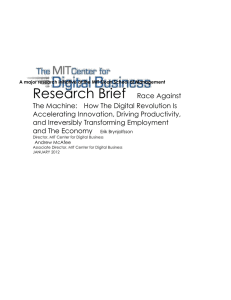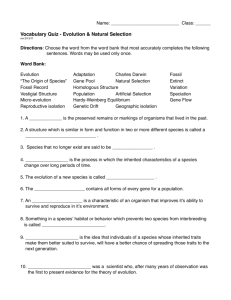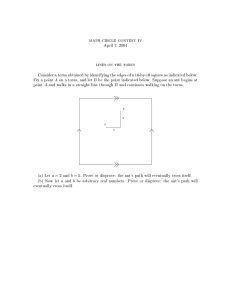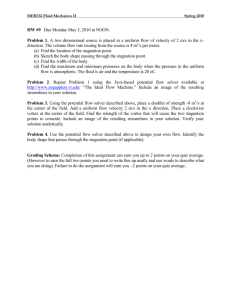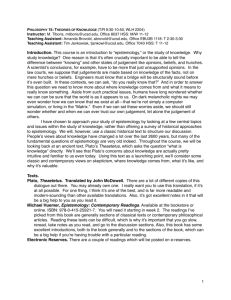Race Against The Machine - MIT Center for Digital Business
advertisement
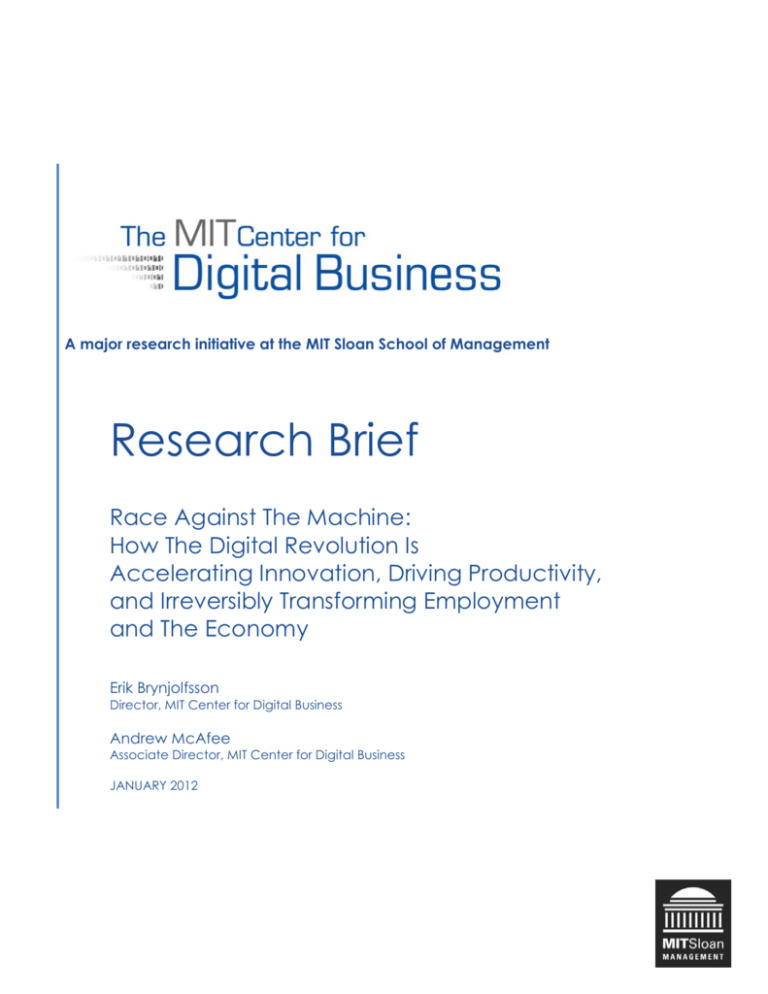
A major research initiative at the MIT Sloan School of Management Research Brief Race Against The Machine: How The Digital Revolution Is Accelerating Innovation, Driving Productivity, and Irreversibly Transforming Employment and The Economy Erik Brynjolfsson Director, MIT Center for Digital Business Andrew McAfee Associate Director, MIT Center for Digital Business JANUARY 2012 Technology’s Influence On Employment and The Economy This is a summary article on the recent ebook published by the authors about how information technologies are affecting jobs, skills, wages, and the economy. An Economy That’s Not Putting People Back to Work Of all the grim statistics and stories accompanying the recent Great Recession and subsequent recovery, those related to employment were the worst. Recessions always increase joblessness, of course, but between May 2007 and October 2009 unemployment jumped by more than 5.7 percentage points, the largest increase in the postwar period. The grim unemployment statistics puzzled many because other measures of business health rebounded pretty quickly after the Great Recession officially ended in June 2009. And by 2010, investment in equipment and software returned to 95% of its historical peak, the fastest recovery of equipment investment in a generation. Economic history teaches that when companies grow, earn profits, and buy equipment, they also typically hire workers. But American companies didnʼt resume hiring after the Great Recession ended. The volume of layoffs quickly returned to pre-recession levels, so companies stopped shedding workers. But the number of new hires remained severely depressed. Companies brought new machines in, but not new people. Where Did the Jobs Go? Why has the scourge of unemployment been so persistent? Analysts offer three alternative explanations: cyclicality, stagnation, and the “end of work.” The cyclical explanation holds that there’s nothing new or mysterious going on; unemployment in America remains so high simply because the economy is not growing quickly enough to put people back to work. What America has been experiencing since 2007, in short, is another case of the business cycle in action, albeit a particularly painful one. A second explanation for current hard times sees stagnation, not cyclicality, in action. Stagnation in this context means a long-term decline in Americaʼs ability to innovate and increase productivity. The stagnation argument doesnʼt ignore the Great Recession, but also doesnʼt believe that itʼs the principle cause of the current slow recovery and high joblessness. These woes have a more fundamental source: a slowdown in the kinds of powerful new ideas that drive economic progress. “[S]tagnationists” hold that only higher rates of innovation and technical progress will lift the economy out of its current doldrums. The third explanation for Americaʼs current job creation problems flips the stagnation argument on its head, seeing not too little recent technological progress, but instead too much. Weʼll call this the “end of work” argument, after Jeremy Rifkinʼs 1995 book of the same title. Rifkin wrote, “Today, all ... sectors of the economy ... are experiencing technological displacement, forcing millions onto the unemployment rolls.” The end-of-work argument is an intuitively appealing one, but low unemployment levels in the United States throughout the 1980s, ʼ90s, and first seven years of the new millennium did much to discredit fears of displacement, and it has not been featured in the mainstream discussion of todayʼs jobless recovery. As technology journalist Farhad Manjoo summarized in the online magazine Slate, “Most economists aren’t taking these January 2012 worries very seriously. The idea that computers might significantly disrupt human labor markets – and thus further weaken the global economy – so far remains on the fringes.” Our Goal: Bringing Technology Into the Discussion We think itʼs time to bring this idea into the mainstream and to pay more attention to technologyʼs impact on skills, wages, and employment. Cyclical weak demand is not the whole story. The stagnationists correctly point out that median income and other important measures of American economic health stopped growing robustly some time ago, but we disagree with them about why this has happened. They think itʼs because the pace of technological innovation has slowed down. We think itʼs because the pace has sped up so much that itʼs left a lot of people behind. We agree with the end-of-work crowd that computerization is bringing deep changes, but weʼre not as pessimistic as they are. In fact, some human skills are more valuable than ever, even in an age of incredibly powerful and capable digital technologies. But other skills have become worthless, and people who hold the wrong ones now find that they have little to offer employers. Theyʼre losing the race against the machine, a fact reflected in todayʼs employment statistics. We wrote this ebook because we believe that digital technologies are one of the most important driving forces in the economy today. It may seem paradoxical that faster progress can hurt wages and jobs for millions of people, but we argue thatʼs whatʼs been happening. As weʼll show, computers are now doing many things that used to be the domain of people only. The root of our problems is not that weʼre in a Great Recession, or a Great Stagnation, but rather that we are in the early throes of a Great Restructuring. So itʼs urgent that we understand these phenomena, discuss their implications, and come up with strategies that allow human workers to race ahead with machines instead of racing against them. Humanity and Technology On The Second Half of the Chessboard We used to be pretty confident that we knew the relative strengths and weaknesses of computers vis-à-vis humans. But computers have started making inroads in some unexpected areas. This fact helps us to better understand the past few turbulent years and the true impact of digital technologies on jobs. A good illustration of how much recent technology advances have taken us by surprise comes from The New Division of Labor by economists Frank Levy and Richard Murnane. In the bookʼs second chapter, “Why People Still Matter,” the authors present a spectrum of information-processing tasks. At one end are straightforward applications of existing rules. At the other end of the complexity spectrum are pattern-recognition tasks where the rules canʼt be inferred. The New Division of Labor gives driving in traffic as an example of this type of task, and asserts that it is not automatable. Levy and Murnane were correct that automatic driving on populated roads is an enormously difficult task, and itʼs not easy to build a computer that can substitute for human perception and pattern matching in this domain. Not easy, but not impossible either—this challenge has largely been met. Levy and Murnane give complex communication as another example of a human capability thatʼs very hard for machines to emulate. Evolution has “programmed” people to do this January 2012 effortlessly, but itʼs been very hard to program computers to do the same. The Google driverless car shows how far and how fast digital pattern recognition abilities have advanced recently. Lionbridgeʼs GeoFluent shows how much progress has been made in computersʼ ability to engage in complex communication. Another technology developed at IBMʼs Watson labs, this one actually named Watson, shows how powerful it can be to combine these two abilities and how far the computers have advanced recently into territory thought to be uniquely human. Moore’s Law and the Second Half of the Chessboard How has science fiction become business reality so quickly? Two concepts are essential for understanding this remarkable progress. The first, and better known, is Mooreʼs Law, which is an expansion of an observation made by Gordon Moore, cofounder of microprocessor maker Intel. In a 1965 article in Electronics Magazine, Moore noted that the number of transistors in a minimum-cost integrated circuit had been doubling every 12 months, and predicted that this same rate of improvement would continue into the future. When this proved to be the case, Mooreʼs Law was born. Variations of Mooreʼs Law have been applied to improvement over time in disk drive capacity, display resolution, and network bandwidth. The second concept relevant for understanding recent computing advances is closely related to Mooreʼs Law. It comes from an ancient story about math made relevant to the present age by the innovator and futurist Ray Kurzweil. In one version of the story, the inventor of the game of chess shows his creation to his countryʼs ruler. The emperor is so delighted by the game that he allows the inventor to name his own reward. The clever man asks for a quantity of rice to be determined as follows: one grain of rice is placed on the first square of the chessboard, two grains on the second, four on the third, and so on, with each square receiving twice as many grains as the previous. The emperor agrees, thinking that this reward was too small. He eventually sees, however, that the constant doubling results in tremendously large numbers. The inventor winds up with 264 1 grains of rice, or a pile bigger than Mount Everest. In some versions of the story the emperor is so displeased at being outsmarted that he beheads the inventor. In his 2000 book The Age of Spiritual Machines: When Computers Exceed Human Intelligence, Kurzweil notes that the pile of rice is not that exceptional on the first half of the chessboard: “After thirtytwo squares, the emperor had given the inventor about 4 billion grains of rice. Thatʼs a reasonable quantity—about one large fieldʼs worth—and the emperor did start to take notice. But the emperor could still remain an emperor. And the inventor could still retain his head. It was as they headed into the second half of the chessboard that at least one of them got into trouble.” Kurzweilʼs point is that constant doubling, reflecting exponential growth, is deceptive because it is initially unremarkable. Exponential increases initially look a lot like standard linear ones, but theyʼre not. As time goes by—as we move into the second half of the chessboard—exponential growth confounds our intuition and expectations. It accelerates far past linear growth, yielding Everest-sized piles of rice and computers that can accomplish previously impossible tasks. So where are we in the history of business use of computers? Are we in the second half of the chessboard yet? Advances like the Google autonomous car, Watson the Jeopardy! champion January 2012 supercomputer, and high-quality instantaneous machine translation can be seen as the first examples of the kinds of digital innovations weʼll see as we move further into the second half—into the phase where exponential growth yields jawdropping results. Computing the Economy: The Economic Power of General Purpose Technologies These results will be felt across virtually every task, job, and industry. Such versatility is a key feature of general purpose technologies (GPTs), a term economists assign to a small group of technological innovations so powerful that they interrupt and accelerate the normal march of economic progress. Steam power, electricity, and the internal combustion engine are examples of previous GPTs. It is difficult to overstate their importance. GPTs not only get better themselves over time (and as Mooreʼs Law shows, this is certainly true of computers), they also lead to complementary innovations in the processes, companies, and industries that make use of them. They lead, in short, to a cascade of benefits that is both broad and deep. Computers are the GPT of our era, especially when combined with networks and labeled “information and communications technology” (ICT). Computers and networks bring an everexpanding set of opportunities to companies and changes build and feed on each other so that the possibilities offered really are constantly expanding. Where People Still Win (at Least for Now) Although computers are encroaching into territory that used to be occupied by people alone, like advanced pattern recognition and complex communication, for now humans still hold the high ground in the physical domain, and many physical jobs also require advanced mental abilities. Even in the domain of pure knowledge work— jobs that donʼt have a physical component—thereʼs a lot of important territory that computers havenʼt yet started to cover. Computers so far have proved to be great pattern recognizers but lousy general problem solvers; and for all their power and speed, todayʼs digital machines have shown little creative ability. But as the examples in this chapter make clear, computers are now demonstrating skills and abilities that used to belong exclusively to human workers. This trend will only accelerate as we move deeper into the second half of the chessboard. What are the economic implications of this phenomenon? Weʼll turn our attention to this topic in the next chapter. Creative Destruction: The Economics of Accelerating Technology and Disappearing Jobs The individual technologies and the broader technological acceleration we’re experiencing are creating enormous value. There is no question that they increase productivity, and thus our collective wealth. But at the same time, the computer, like all general purpose technologies, requires parallel innovation in business models, organizational processes structures, institutions, and skills. While the foundation of our economic system presumes a strong link between value creation and job creation, the Great Recession reveals the weakening or breakage of that link. Technology has advanced rapidly, and the good news is that January 2012 this has radically increased the economy’s productive capacity. However, technological progress does not automatically benefit everyone in a society. In particular, incomes have become more uneven, as have employment opportunities. Recent technological advances have favored some skill groups over others, particularly “superstars” in many fields, and probably also increased the overall share of GDP accruing to capital relative to labor. The stagnation in median income is not because of a lack of technological progress. On the contrary, the problem is that our skills and institutions have not kept up with the rapid changes in technology. In the 19th and 20th centuries, as each successive wave of automation eliminated jobs in some sectors and occupations, entrepreneurs identified new opportunities where labor could be redeployed and workers learned the necessary skills to succeed. Millions of people left agriculture, but an even larger number found employment in manufacturing and services. In the 21st century, technological change is both faster and more pervasive. While the steam engine, electric motor, and internal combustion engine were each impressive technologies, they were not subject to an ongoing level of continuous improvement anywhere near the pace seen in digital technologies. Already, computers are thousands of times more powerful than they were 30 years ago, and all evidence suggests that this pace will continue for at least another decade, and probably more. Furthermore, computers are, in some sense, the “universal machine” that has applications in almost all industries and tasks. In particular, digital technologies now perform mental tasks that had been the exclusive domain of humans in the past. General purpose computers are directly relevant not only to the 60% of the labor force involved in information processing tasks but also to more and more of the remaining 40%. As the technology moves into the second half of the chessboard, each successive doubling in power will increase the number of applications where it can affect work and employment. As a result, our skills and institutions will have to work harder and harder to keep up lest more and more of the labor force faces technological unemployment. What is to Be Done? Prescriptions and Recommendations In medicine, law, finance, retailing, manufacturing, and even scientific discovery, the key to winning the race is not to compete against machines but to compete with machines. While computers win at routine processing, repetitive arithmetic, and error-free consistency and are quickly getting better at complex communication and pattern matching, they lack intuition and creativity and are lost when asked to work even a little outside a predefined domain. Fortunately, humans are strongest exactly where computers are weak, creating a potentially beautiful partnership. So in this chapter we want to focus on recommendations in two areas: improving the rate and quality of organizational innovation, and increasing human capital— ensuring that people have the skills they need to participate in todayʼs economy, and tomorrowʼs. Making progress in these two areas will be the best way to allow human workers and institutions to race with machines, not against them. Fostering Organizational Innovation How can we implement a “race with machines” strategy? The solution is organizational innovation: co-inventing new January 2012 organizational structures, processes, and business models that leverage everadvancing technology and human skills. The stagnation of median wages and polarization of job growth is an opportunity for creative entrepreneurs. They can develop new business models that combine the swelling numbers of mid-skilled workers with evercheaper technology to create value. There has never been a worse time to be competing with machines, but there has never been a better time to be a talented entrepreneur. Digital technologies create enormous opportunities for individuals to use their unique and dispersed knowledge for the benefit of the whole economy. But are there enough opportunities for all these entrepreneurs? Are we running out of innovations? When businesses are based on bits instead of atoms, then each new product adds to the set of building blocks available to the next entrepreneur instead of depleting the stock of ideas the way minerals or farmlands are depleted in the physical world. Because the process of innovation often relies heavily on the combining and recombining of previous innovations, the broader and deeper the pool of accessible ideas and individuals, the more opportunities there are for innovation. We are in no danger of running out of new combinations to try. Even if technology froze today, we have more possible ways of configuring the different applications, machines, tasks, and distribution channels to create new processes and products than we could ever exhaust. Investing in Human Capital Technology races ahead ever faster as we move deeper into the second half of the chessboard. To keep up, we need not only organizational innovation, orchestrated by entrepreneurs, but also a second broad strategy: investments in the complementary human capital—the education and skills required to get the most out of our racing technology. Unfortunately, our educational progress has stalled and this is reflected in stagnating wages and fewer jobs. Although the United States once led the world in the education of its citizens, it has fallen from first to tenth in the share of citizens who are college graduates. It’s not a coincidence that the educational sector also lags as an adopter of information technologies. The optimistic interpretation is that we have tremendous upside potential for improvements in education. As education becomes increasingly digitized, educators can experiment and track alternative approaches, measure and identify what works, share their findings, and replicate the best approaches in other subjects and geographies. This enables a faster pace of innovation, leading to further improvements in educational productivity. It also enables unbundling of instruction, evaluation, and certification, which encourages educational systems to be based more on delivering genuine, measurable results and less on simply signaling selection, effort, and prestige. Furthermore, using IT, both scale and customization can be increased dramatically. Combining videoconferencing, software, and networks with local teachers and tutors has a number of potential advantages. In particular, softer skills like leadership, team building, and creativity will be increasingly important. They are the areas least likely to be automated and most in demand in a dynamic, entrepreneurial economy. Conclusion: The Digital Frontier In this piece weʼve concentrated on how our increasingly powerful digital technologies affect skills, jobs, and the January 2012 demand for human labor. Weʼve stressed that computers are rapidly encroaching into areas that used to be the domain of people only, like complex communication and advanced pattern recognition. And weʼve shown how this encroachment can cause companies to use more computers and fewer people in a growing set of tasks. As we head deeper into the second half of the chessboard—into the period where continuing exponential increases in computing power yield astonishing results—we expect that economic disruptions will only grow as well. But we clearly are not pessimists about technology and its impacts. Technology has already opened up a huge amount of rich new territory and will keep doing so. with a general purpose technology. The first, powered by steam, the second, based on electricity. The third industrial revolution, which is unfolding now, is fuelled by computers and networks. Like both of the previous ones, it will take decades to fully play out. And like each of the first two, it will lead to sharp changes in the path of human development and history. The twists and disruptions will not always be easy to navigate. But we are confident that most of these changes will be beneficial ones, and that we and our world will prosper on the digital frontier. A World of Benefits Information doesnʼt get used up even when itʼs consumed. And once a book or other body of information is digitized, even more possibilities open up. The economics of digital information, in short, are the economics not of scarcity but of abundance. This is a fundamental shift, and a fundamentally beneficial one. If you have Internet access and a connected device today, itʼs both free and easy to keep in touch with the people who mean something to you—your kith and kin—even as you and they move around. As digital technologies make markets and businesses more efficient, they benefit all of us as consumers. As they increase government transparency and accountability and give us new ways to assemble and make our voices heard, they benefit us as citizens. And as they put us in touch with ideas, knowledge, friends, and loved ones, they benefit us as human beings. So as we observe the opening up of the digital frontier, we are hugely optimistic. History has witnessed three industrial revolutions, each associated January 2012
